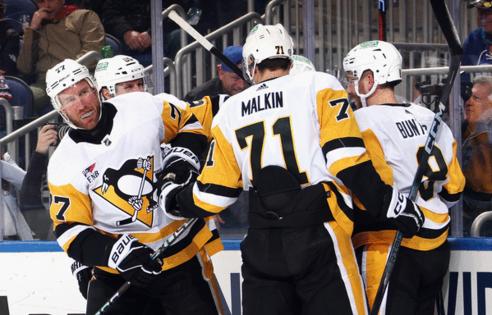Cameron Hoover: Kyle Dubas said he wanted to make the Penguins younger this offseason. Did he succeed?
Published in Hockey
PITTSBURGH — Penguins president of hockey operations Kyle Dubas had one clear-cut objective this offseason: Make the team younger.
After the Penguins disappointed and missed the Stanley Cup Playoffs for a second consecutive campaign — squandering another spectacular season from Sidney Crosby — many wondered if the rebuild would truly get underway.
Dubas dispelled those notions pretty quickly at his end-of-season wrap-up press conference.
Rather than going "full-on scorched earth," as he put it, Dubas elected for a more measured approach, hoping to restock the roster with younger, perhaps more energetic talent — and the team's war chest with more fruitful future assets — to give his core of aging stars one last run at another championship together.
"The easy answer when you're up here is to say, 'OK, we're just going to rip it all the way down, and it's going to require patience, and it's going to be painful,' " Dubas said back in April. "With our group, it would be foolish not to try to get those younger players in around [veteran leaders] like Sid, like Kris Letang, like Bryan Rust. ...
"My view is that there are more examples of late of teams that contended when [Pittsburgh] was contending that have pivoted in short order to replenishing their younger group of assets — whether that's prospects, picks or players — and then turning quickly while the key members of their group were still there."
Many things need to happen for the Penguins to return to prominence and make some real noise in the playoffs, but Dubas is betting that a more exuberant, youthful roster is one of those.
Now, as the NHL offseason wanes and training camp appears on the horizon, let's look at who's in and who's out to see if Dubas accomplished his task. But first ...
Are the Penguins even actually that old?
Yes, they are.
The Penguins' opening-night roster last season averaged 30.6 years of age, the oldest in the league and a full year older than Carolina, Seattle and Minnesota, who all tied for second at 29.3 years old. The Stanley Cup-winning Florida Panthers were the 19th oldest at an average of 28 years flat.
Crosby just celebrated his 37th birthday. He's one of the greatest of all time, but Father Time comes for everyone eventually. Dubas and the Penguins have to wonder how many more seasons Crosby can produce at this high level while also showcasing the durability to play all 82 games.
Each of the Penguins' top six returning point scorers from last season — Crosby, Evgeni Malkin, Bryan Rust, Erik Karlsson, Kris Letang and Rickard Rakell — is over 30 years old. Only three players under 25 — Pierre-Olivier Joseph, Drew O'Connor and Valtteri Puustinen — recorded more than 10 points.
Dubas' roster construction goal of longevity and sustainability that he laid out was a wise one. With the clock ticking on many of those Penguins legends, it's imperative to surround them with fresher legs.
Doing the math
In: Matt Grzelcyk, Anthony Beauvillier, Blake Lizotte, Sebastian Aho, Cody Glass, Kevin Hayes
Average age: 28 years, 163 days
Out: Jake Guentzel, Reilly Smith, Jeff Carter, Pierre-Olivier Joseph, Chad Ruhwedel, Jansen Harkins, Radim Zohorna
Average age: 31 years, 36 days
Taking it at its most literal face value, Dubas did make the Penguins younger this offseason, as his acquisitions average about 2 1/2 years younger than his departures. (Ages are current as of Tuesday.)
Bear in mind that these lists aren't entirely comprehensive. For the departures, we drew the cut-off at 30 games played for the Penguins last season. Cameos like Vinnie Hinostroza weren't included. For the acquisitions, we only picked players on full-time NHL contracts, so two-way guys like Mac Hollowell and Corey Andonovski, who typically tend to skew younger, also weren't on the list.
Though the acquisitions clock in at an average age of 28 years and 163 days, that number is skewed a bit by veteran 32-year-old forward Kevin Hayes. Four of the six listed there are 28 years of age or younger, with Matt Grzelcyk being the other 30-plus-year-old.
So the Penguins are significantly younger, mathematically speaking — but with a Jeff Carter-sized caveat.
The figures on the departures are, of course, buoyed by the retirement of Carter, the 39-year-old two-time Stanley Cup winner who hung up the skates after last season. Whoever replaces Carter in the Penguins' bottom six will certainly be an upgrade in terms of youth and speed. But when you take the outlier Carter out of this equation, the age gap between last season's team and this one shrinks.
The departure of Jake Guentzel, who was traded to Carolina last season and then to Tampa Bay this offseason, will be felt mostly as the Penguins keep trying to recreate his years of on-ice production with Crosby. But the baby-faced Nebraskan is no spring chicken either — he turns 30 in October and is entering his ninth NHL season.
This directive from Penguins brass, though, makes Joseph's departure all the more puzzling. Joseph signed a one-year, $950,000 contract with St. Louis over the offseason for an opportunity to play with his brother, Mathieu. But at 25 years old — and certainly not with an exorbitant price tag — Joseph seemed like just the kind of young, controllable defenseman Dubas might be looking for now. Instead, the Penguins will hope Grzelcyk or Sebastian Aho — both older than Joseph — can take his spot.
On that very literal level, Dubas did what he set out to do. This year's Penguins team will be younger than the previous. How those players produce, though, is another question entirely.
Restocking the cupboard
As Dubas attempts to position the team for one last hurrah with Crosby and Co., he also has one eye toward the future.
The Penguins' war chest of future assets looked rather bleak when Dubas took over, but he's steadily built a solid supply for the next few years. He hired his former coworker and Maple Leafs draft guru Wes Clark to prepare for the next few years of picks.
Dubas also employed an interesting strategy this offseason of taking on teams' unwanted extra salary in exchange for draft capital. He got a 2025 third-round pick and a 2026 sixth-rounder from Nashville for taking on Cody Glass' $2.5 million cap hit. After some finagling, Dubas ended up with a 2025 third-rounder and a 2026 second-rounder for bringing Kevin Hayes and his $3.6 million salary aboard.
All said, over the next three drafts, the Penguins have three first-round picks, four second-rounders, six third-rounders and four fourth-rounders. Depending on how good (or bad) the team is over the next couple of seasons, those picks could become even more valuable to restock a depleted farm system.
Beyond that, there are still other youngsters waiting in the wings. Sam Poulin is finally nearing a regular NHL role after a long journey filled with adversity. Top prospect Brayden Yager just signed his first professional deal and will strive to break camp with the big club. Defenseman Jack St. Ivany impressed in his audition last season. Goalie Joel Blomqvist is putting the pressure on Tristan Jarry and Alex Nedeljkovic for a spot. Vasily Ponomarev, Ville Koivunen and Tristan Broz are all players we could see over the next couple of seasons.
So, yes, Dubas made the Penguins younger, but did he make them better? Whether the newly constructed roster will result in a return trip to the postseason is still to be seen.
(c)2024 the Pittsburgh Post-Gazette Distributed by Tribune Content Agency, LLC.







Comments